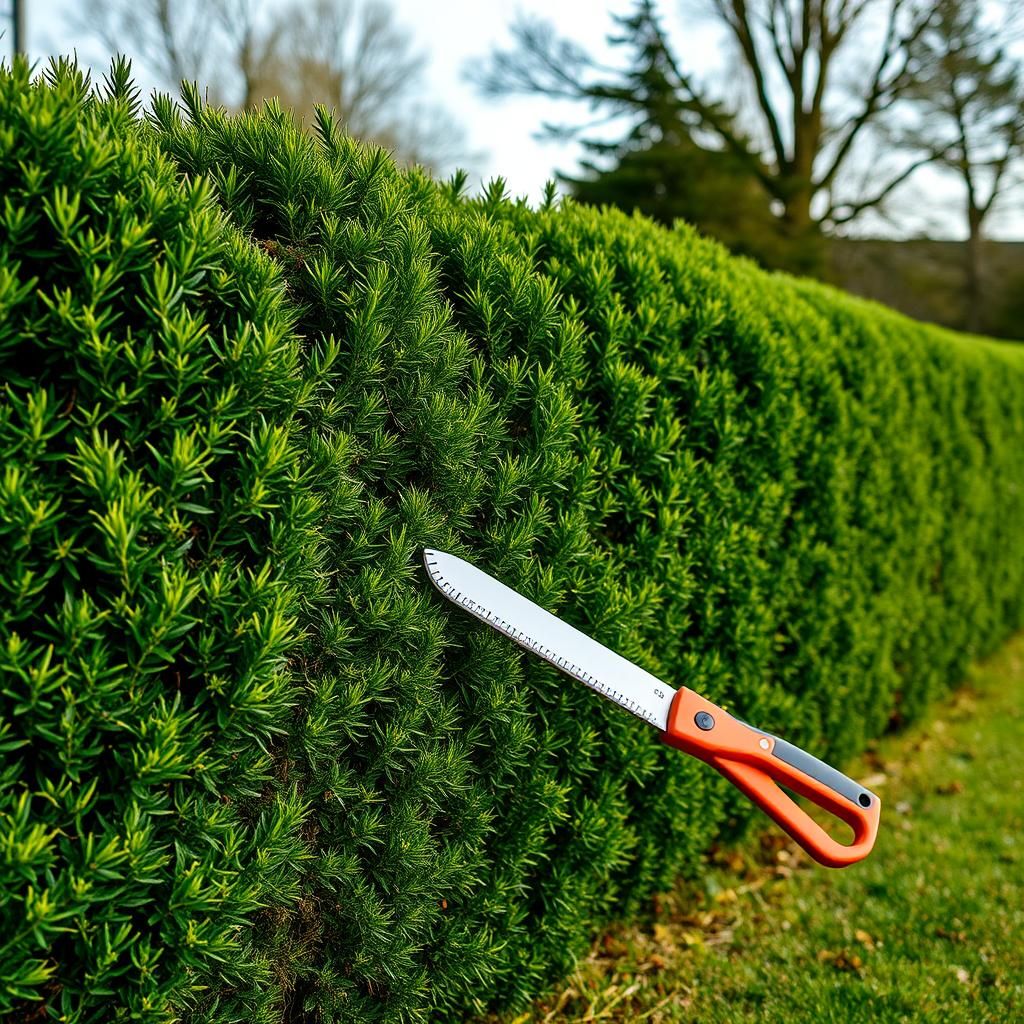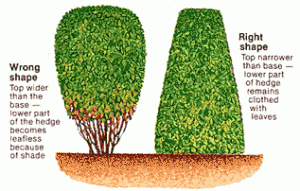When shouldn't you cut a hedge? Essential Guidelines for Proper Hedge Maintenance

Hedge maintenance is an essential aspect of garden care, contributing not only to aesthetics but also to the health of the plants. However, knowing when not to trim your hedges is equally important to ensure optimal growth and vibrancy. Pruning at the wrong time can lead to stunted growth, reduced flowering, and even damage to the plants. This article will explore the crucial guidelines for when hedge trimming should be avoided, helping you make informed decisions to foster a thriving garden environment. From seasonal considerations to the effects on wildlife, understanding these factors can lead to more responsible hedge management.
When Shouldn't You Cut a Hedge?
Cutting a hedge can be a vital aspect of garden maintenance, yet there are specific times when it is unwise to undertake this task. Primarily, avoid trimming hedges during the breeding season of birds, which typically spans from early spring to mid-summer. This is crucial as many birds nest in hedges, and cutting them during this period can disrupt their habitat, leading to potential loss of young birds. Additionally, consider the weather conditions; trimming during extremely hot, dry summers can stress the plants, while cutting during frosty winter months can leave them susceptible to damage. Lastly, if the hedge is showing any signs of disease, pruning may worsen the situation.
Breeding Season of Birds
During the breeding season, from around March to August, many birds find refuge and nesting sites in hedges. Cutting back hedges at this time not only jeopardizes the nests but can also lead to interference with the birds’ natural reproductive cycle. Therefore, to protect wildlife and maintain ecological balance, it is critical to avoid hedge trimming during these months.
Weather Conditions
Weather plays a significant role in hedge maintenance; for instance, trimming during periods of extreme heat can lead to dehydration and stress on the plants. Similarly, performing cuts just before or during a cold snap can result in frost damage to newly exposed areas of the hedge. Consequently, it's advisable to schedule maintenance only when conditions are favorable, ideally during early spring or late summer.
Health of the Hedge
Before proceeding with hedge trimming, one must always assess the health of the plants. If the hedge exhibits any signs of disease, such as wilting leaves, discoloration, or unusual growth patterns, cutting it may exacerbate the issue. Instead, focus on improving the overall health through appropriate soil management, watering, and pest control before considering any major cuts.
Legal Restrictions and Regulations
In some areas, there may be legal restrictions on hedge trimming, especially if the hedge is in proximity to public paths or properties. It is essential to be mindful of local regulations before cutting hedges to avoid potential fines or disputes with neighbors. Always check with local authorities to ensure compliance with any related laws.
Seasonal Growth Patterns
Different types of hedges have specific growth patterns that can affect the optimal times for trimming. For many evergreen shrubs, the best time for pruning is just after their growth spurt in late spring. Conversely, deciduous varieties may benefit from trimming in late winter to promote fuller regrowth. Understanding these patterns can help ensure that the hedge remains lush and healthy throughout the seasons.
| Consideration | Key Points |
|---|---|
| Breeding Season | Avoid trimming from March to August to protect bird nests. |
| Weather Conditions | Cutting in extreme heat or frost can harm plants. |
| Hedge Health | Assess for disease before pruning to avoid worsening issues. |
| Legal Restrictions | Check local regulations about trimming near public areas. |
| Seasonal Growth | Understand specific pruning times for different hedge types. |
When should you not trim your hedges?

When considering the right time to trim your hedges, there are several important factors to keep in mind. Trimming at the wrong time can lead to poor growth, damage to the plant, and reduced flowering. Here are some instances when you should not trim your hedges:
1. During Extreme Weather Conditions
Trimming your hedges during periods of extreme weather, such as intense heat or severe cold, can stress the plants. Hedges can be more susceptible to damage when they are already stressed by temperature extremes. It is advisable to wait until the weather stabilizes to ensure the health of the plant remains intact. Conditions to avoid include:
- High summer heat that may cause dehydration.
- Frosty conditions that can damage fresh cuts.
- Heavy rains that can lead to soil erosion and instability.
2. During the Bird Breeding Season
Trimming hedges during the bird breeding season, typically from late spring to early summer, can disrupt nesting birds. It is crucial to be aware of local wildlife regulations as many birds are protected by law. By avoiding trimming during this period, you can help preserve local biodiversity. Key considerations include:
- Identifying the breeding season in your area.
- Observing signs of birds nesting before trimming.
- Consulting local wildlife organizations if unsure.
3. When Plants Are Bloomin
If your hedges are flowering, it is best to refrain from trimming. Cutting back during this time can remove buds and significantly affect future blooms. Additionally, some plants may take time to recover from being trimmed, leading to an unattractive appearance. Tips for managing flowering hedges include:
- Identifying the flowering time for your hedge species.
- Planning to trim after blooming has completed.
- Keeping pruning tools ready for the right moment.
4. When Hedges Are Already Weak or Sick
If your hedges are showing signs of stress, disease, or pest infestation, trimming can worsen their condition. It is better to focus on nurturing and rehabilitating the plant first before considering any trimming. Strategies to address weak or sick hedges include:
See also:
- Identifying the underlying issues affecting plant health.
- Consulting a botanist or horticulturist for expert advice.
- Applying treatments to improve health before trimming.
5. In Late Fall or Winter
Trimming hedges in late fall or winter can put new growth at risk of winter damage. During these seasons, plants are preparing for dormancy, and improper pruning can lead to weak growth in the spring. To protect your hedges during colder months, consider:
- Timing your trimming in early spring before growth starts.
- Avoiding any significant cuts just before frost.
- Monitoring weather forecasts to time your last trim correctly.
What month should I trim my hedges?

To determine the best month to trim hedges, it generally depends on the type of hedge you have and your local climate. However, a common recommendation is to trim hedges in the late winter to early spring, around March or April in many regions. This timing allows the plants to recover from pruning before the growing season begins, promoting healthy new growth.
Best Time for Different Types of Hedges
The best time to trim hedges can vary based on their species. Here are a few examples of common hedge types and their optimal pruning times:
- Deciduous Hedges: These are best trimmed in late winter or early spring, just as buds begin to swell. This prevents unnecessary stress on the plants.
- Evergreen Hedges: Trimming should ideally take place in late spring after the last frost but can also be done in early summer for maintenance.
- Flowering Hedges: For those that bloom in spring, such as forsythia, it is essential to prune them right after flowering to ensure the next year’s blooms.
Signs Your Hedges Need Trimming
Knowing when to trim hedges is essential, but here are some signs to look for that indicate it's time for maintenance:
- Overgrowth: Hedges that have become unruly or are encroaching on pathways or structures need to be trimmed.
- Dead or Brown Branches: These are unsightly and can often signify the need for rejuvenation through trimming.
- Loss of Shape: Hedges that have lost their formal shape or aesthetic appeal benefit from a trim to restore order.
Impact of Climate on Trimming Timeline
Your local climate can significantly influence when is the best month to trim hedges. Consider the following factors:
- Frost Dates: In colder climates, it is crucial to avoid pruning before the last frost date to prevent damage to new growth.
- Growing Season: In warmer areas, hedges may need more frequent trimming during the year to manage growth.
- Rainfall: High humidity or rainfall during the growing season can increase the need for trim to promote air circulation and reduce disease.
Tools Needed for Trimming Hedges
To effectively trim hedges, having the right tools is essential. The following are recommended:
- Hand Pruners: Ideal for small branches and fine detail work to ensure precision.
- Hedge Shears: These are perfect for shaping and maintaining the overall appearance of the hedge.
- Electric or Gas Hedge Trimmers: Useful for larger hedges where more power and efficiency are required.
Post-Trimming Care for Hedges
After trimming, proper care is vital for the health of your hedges. Follow these tips:
- Watering: Ensure the hedges receive adequate water, especially after pruning, as they need it to recover.
- Mulching: Applying mulch around the base can help retain moisture and provide nutrients.
- Fertilizing: Using a balanced fertilizer after trimming can encourage vigorous growth in the spring.
When should you not use a hedge trimmer?

Using a hedge trimmer can be an effective way to maintain your garden's appearance; however, there are specific situations where it is not advisable to use this tool. Below are detailed circumstances in which you should refrain from using a hedge trimmer.
1. Wet Conditions
Using a hedge trimmer in wet conditions can be hazardous and inefficient. Wet foliage can make it difficult for the trimmer to function properly, and you may inadvertently damage the plants. Additionally, the risk of slips and falls increases when working in wet ground.
- Electric Trimmers: Water and electricity don't mix, creating a significant risk of electric shock.
- Battery Life: If you are using a battery-powered trimmer, moisture can drain the battery faster or cause malfunction.
- Blade Efficiency: Wet branches can clump together, making cutting less effective and leading to potential strain on the motor.
2. During Extreme Weather
Extreme weather conditions, such as high winds, thunderstorms, or heavy snow, can render hedge trimming dangerous. The risk of flying debris or unstable footing can lead to accidents.
- Wind: Strong winds can cause loss of control over the trimmer, increasing the risk of accidents.
- Lightning: Using electrical tools outdoors during thunderstorms places you at a heightened risk for electric shock.
- Visibility: Poor visibility due to snow or rain can lead to misjudgments and injuries.
3. When the Bushes Are Flowering
Trimming bushes while they are flowering can disrupt their growth cycle and potentially eliminate blooms for the season. This is especially true for certain species of flowering plants.
See also:
- Flowering Cycle: Many plants have specific times when they bloom, and trimming during this phase can inhibit growth.
- Habitat Disruption: Birds and other wildlife often nest in flowering hedges, so trimming can disturb their habitat.
- Aesthetic Loss: Cutting flowers can detract from the visual appeal of your garden during its most vibrant season.
4. For Small or Intricate Hedges
Using a hedge trimmer for small or intricately shaped hedges can lead to uneven cuts and damage. In these cases, manual trimming or smaller tools may yield better results.
- Precision: Hedge trimmers are designed for larger shrubs; precision cutting is better achieved with hand shears.
- Control: Smaller hedges require more control than hedge trimmers typically offer.
- Cleanup: Trimming small hedges can create more debris that is harder to manage with a bulky trimmer.
5. When You Lack Proper Safety Gear
Not wearing the appropriate safety gear can expose you to injury. Safety gear is essential for reducing the risks associated with using a hedge trimmer.
- Eye Protection: Debris and branches can fly into your eyes, making safety goggles necessary.
- Gloves: Proper gloves protect your hands from cuts and vibrations.
- Footwear: Sturdy boots with ankle support can prevent injuries from slips or falling equipment.
Is it bad to trim hedges in the summer?

Trimming hedges in the summer is a topic that can lead to varying opinions among gardeners and landscaping professionals. While some believe it is acceptable, others caution against it due to potential negative impacts on plant health and aesthetics.
The Growth Cycle of Hedges
Understanding the growth cycle of hedges is crucial for determining the best time to trim them. Most hedges have specific periods during the year when their growth peaks and slows down.
- Active Growth Phase: Summer often coincides with the active growth of many hedge species, meaning they are rapidly producing new leaves and branches.
- Stress Factors: Trimming during this time can stress the plant, particularly in hot, dry conditions. This can lead to increased vulnerability to diseases and pests.
- Optimal Timing: For many varieties, late winter or early spring is preferable for trimming as it allows the plant to recover before the summer growth spurt.
Effects on Plant Health
Summer trimming can cause a range of stress effects on hedges, which can ultimately compromise their health and appearance.
- Leaf Damage: Cutting back during the warm months can result in leaf scorch, leading to brown or crispy edges on the remaining foliage.
- Root System Stress: The stress from summer trimming can disrupt the root system, making it harder for the plant to uptake necessary nutrients and water.
- Pest Attraction: Fresh cuts can attract certain pests, further compromising plant health and stability.
Seasonal Aesthetics
The timing of hedge trimming also plays a role in maintaining a desirable appearance throughout the seasons.
- Full Foliage: In summer, hedges are often full and lush; trimming can make the plants look uneven or sparse.
- Maintenance of Shape: Cutting during the wrong time can obscure the natural shape of the hedge, making it appear less tidy and well-kept.
- Seasonal Blooms: Some hedges may have flowers that bloom in summer; trimming can adversely affect these blooms.
Alternative Maintenance Strategies
If trimming in summer is necessary, there are alternative strategies that can minimize negative effects.
- Selective Pruning: Instead of a full trim, consider selective pruning to reduce stress.
- Timing Adjustments: Aim to trim during cooler parts of the day to minimize heat stress on both the plant and the person performing the task.
- Hydration: Ensure adequate watering before and after trimming to help the plant recover from any stress.
Species-Specific Considerations
Different hedge species have unique requirements and responses to summer trimming, making it essential to know what type of hedge you have.
- Deciduous vs. Evergreen: Deciduous hedges may handle summer trimming better than evergreens, which often require more care to maintain shape.
- Flowering Varieties: If the hedge blooms in summer, trimming can significantly impact flower production.
- Growth Rate: Fast-growing species may recover quicker from summer dips compared to slower-growing ones.
Questions from Our Readers
When is it not advisable to cut a hedge?
Cutting a hedge is generally not advisable during the bird nesting season, which usually spans from early spring to early summer, as this can disturb nesting birds and their young. Additionally, extreme weather conditions such as frost or heavy rain can negatively affect the health of the hedge if cut during these times.
What time of year should I avoid trimming my hedge?
You should avoid trimming your hedge during late autumn and winter as this is typically when plants enter dormancy. Cutting hedges at this time can expose them to harsh winter conditions and hinder their growth for the following spring.
Are there specific types of hedges that should not be cut at certain times?
Yes, some flowering hedges should not be cut just before their blooming period; for example, hedges that flower on old wood should be pruned right after they bloom to preserve their flowers for the next season. Always check the growth habits of the specific hedge type you have.
What are the consequences of cutting a hedge at the wrong time?
Cutting a hedge at the wrong time can lead to stress and damage to the plant, making it more susceptible to diseases and pests. In severe cases, it can result in the death of the hedge or an unattractive appearance due to improper growth patterns in the following seasons.
See also:

If you want to read more articles like When shouldn't you cut a hedge? Essential Guidelines for Proper Hedge Maintenance, we recommend you check out our Hedges category.
Leave a Reply
Related Articles